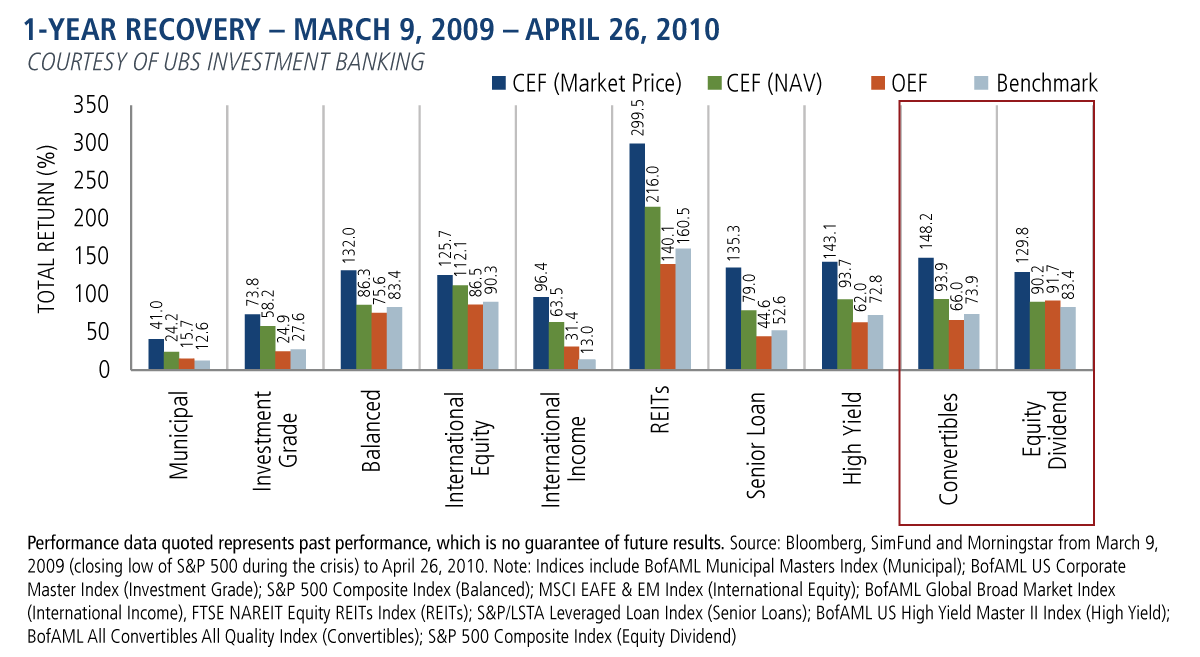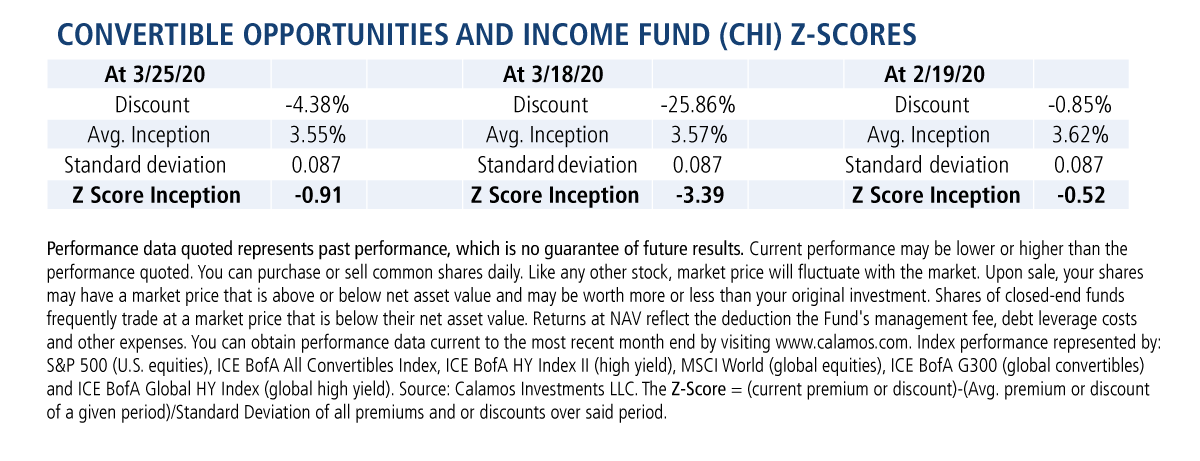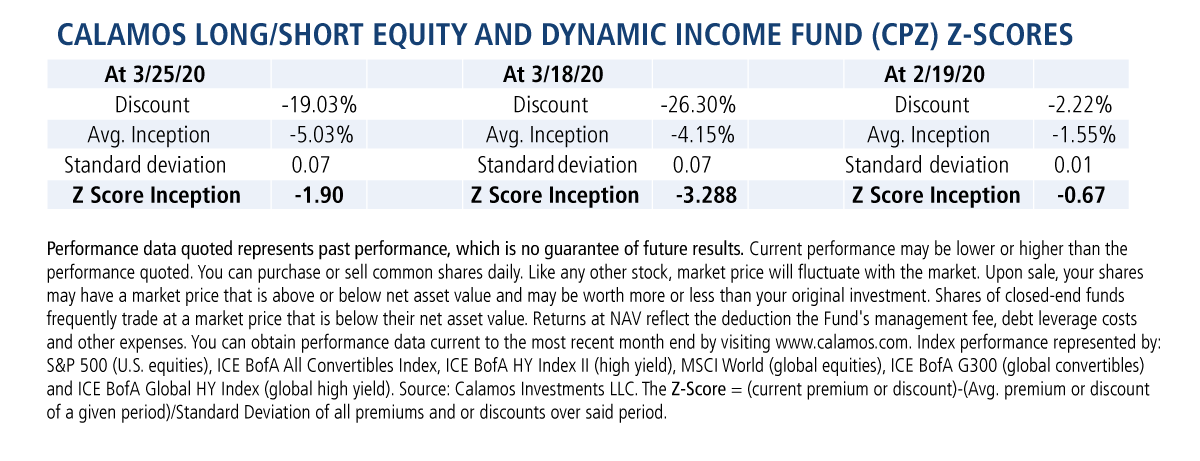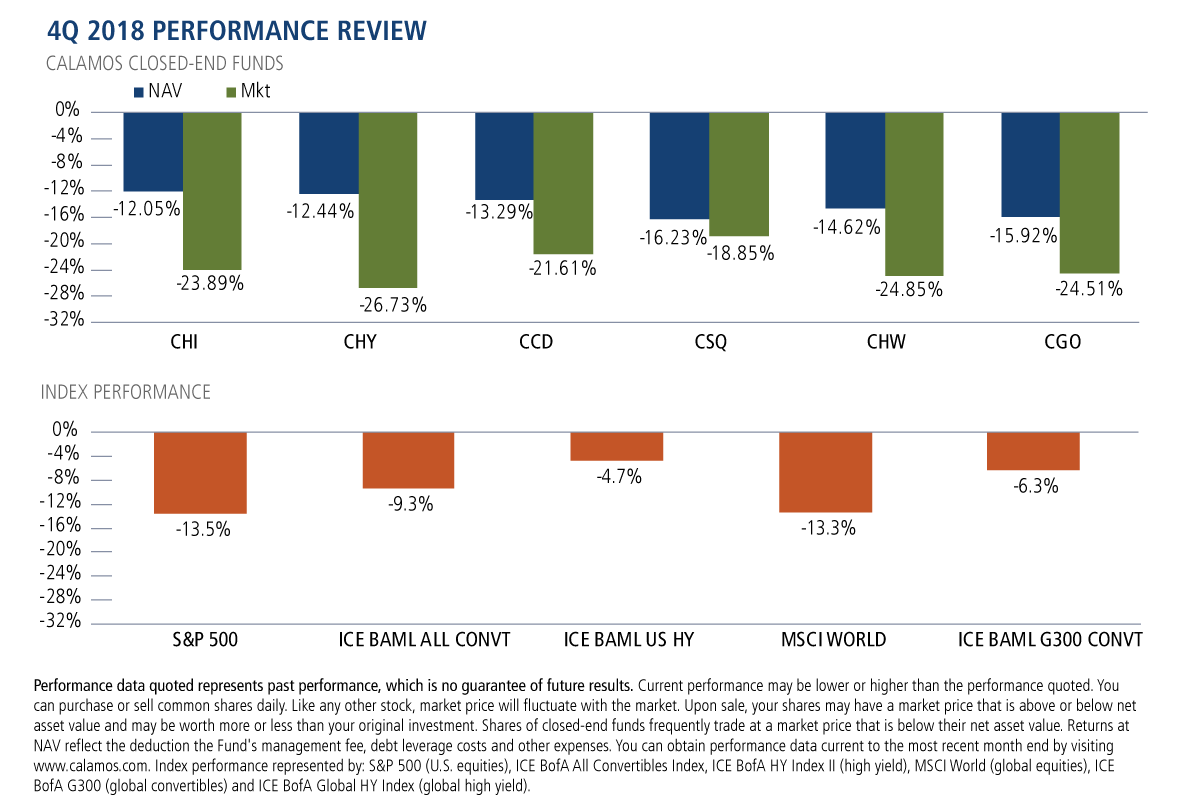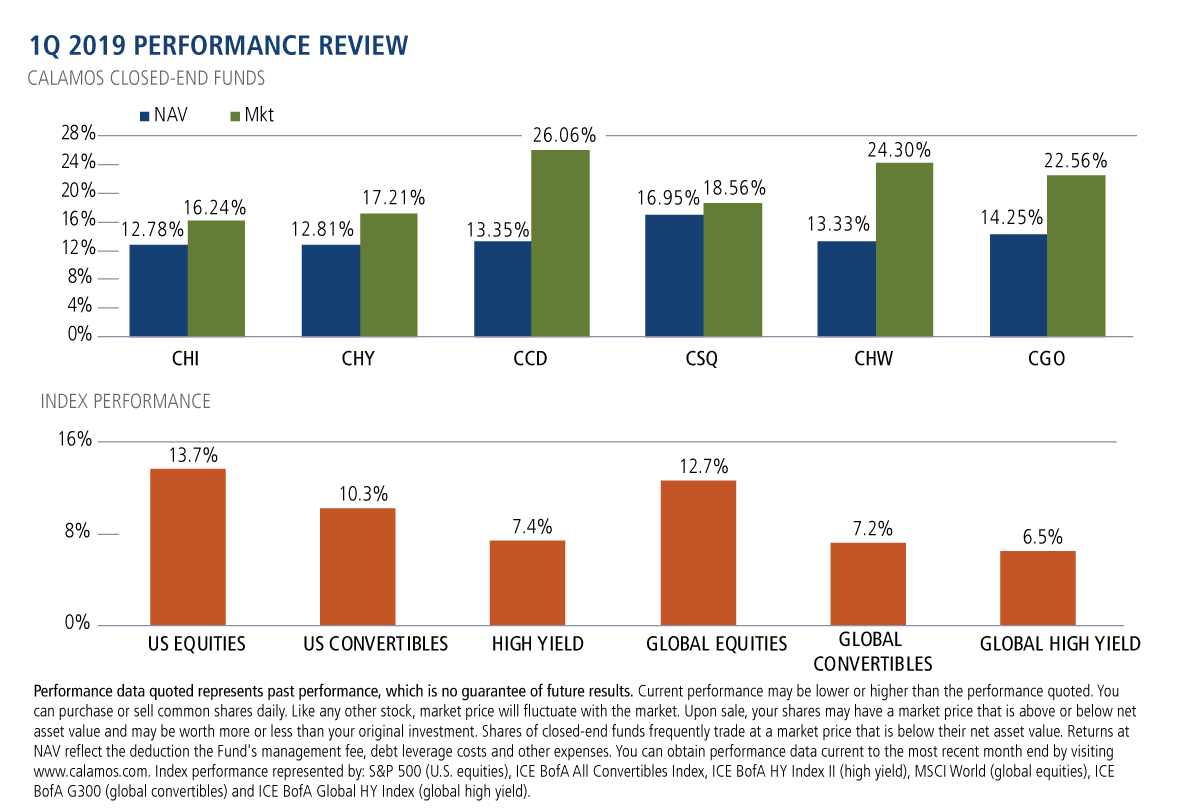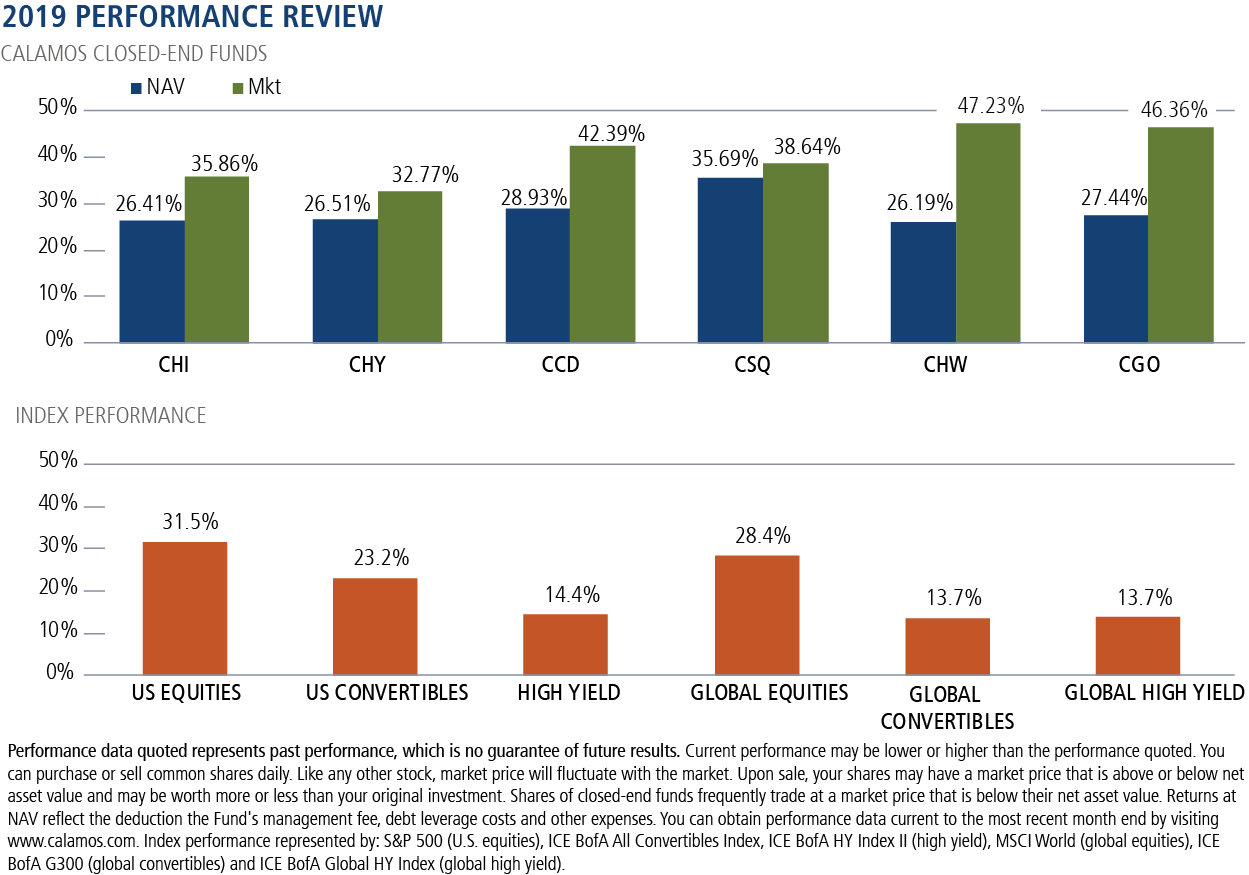Indiscriminate Selling Has Driven Closed-end Fund Discounts, Creating Compelling Value
First published: March 25, 2020
In a turbulent period for the markets, Calamos is hosting a CIO Conference Call Series for financial advisors. Below are notes from a call Friday, March 27, with Robert Bush, Calamos Senior Vice President and Director of Closed-End Fund Products. To listen to the call in its entirety, go to www.calamos.com/CIOcefs-3-27
The comments made by Bob build on what the team had to say on a call last Friday, March 20. Highlights of that call follow. To listen to the March 20 call, go to www.calamos.com/CIOcefs
March 27 Update
Acknowledging continuing investor consternation and angst as the closed-end fund market has experienced a significant amount of stress and volatility over the past several weeks, Bob again addressed dynamics specific to closed-end funds that have resulted in indiscriminate selling this year. He also commented on the structural advantages of CEFs seen in 2009, which enabled many funds to remain fully invested, driving their outperformance during that recovery.
In addition, he introduced the practice of using Z-scores as a means of evaluating the relative value of a current closed-end fund price to its price/NAV historical relationship.
CEFs’ Performance Through the End of Last Week
Prices of closed-end funds are susceptible to wide swings and pressure during extremely volatile markets. They do not always trade in sync with NAVs, and this can be especially so during periods of market volatility (see Bob’s explanation and relevant historical examples in the notes from the March 20 call below). This resulting disparate pricing can be the cause of angst for some, while offering the potential for opportunity to others.
As of last week, the overall closed-end fund universe saw a 33% and 27% decline on market price and NAV returns from the recent highs established on February 19. Equity sectors significantly underperformed their fixed income peers, declining 45% on market price and 40% on NAV from February’s peak. Fixed-income funds saw 25% price and 20% NAV declines over the same period.
Sectors considered safer, including government, municipal, investment grade and general mortgage funds, fared better in recent weeks. Although they all declined alongside broader markets and posted negative returns, their NAV performances were down single-digit or low double-digit year-to-date.
Historical CEF Recovery
With financial markets beginning to recover Tuesday through Thursday, with the S&P 500 up over 17% since Tuesday’s open as of last night, we began to see the outperformance of CEF prices relative to their corresponding NAVs and indexes.

“When financial markets have recovered, the prices of CEFs, which underperformed during the declines, have historically outperformed during the ensuing recoveries.”
The impact of the market turmoil and investor sentiment has directly affected closed-end fund valuations, resulting in a substantial deterioration in discount to levels last seen during the financial crisis. This year, the CEF universe has seen over 1,600 basis points widening in discounts. The moves were particularly severe among taxable fixed income and MLP/energy funds.
However, when financial markets have recovered, the prices of CEFs, which underperformed during the declines, have historically outperformed during the ensuing recoveries. This phenomenon occurred during the 2008 crisis and the start of the ensuing recovery in 2009.
CEFs considerably outperformed open-end mutual funds and respective benchmarks on all sectors, for the one-year period after the depths of the crisis (March 9, 2009 when the S&P 500 reached its closing lows). This was due in part to the structural advantages of CEFs which enabled many to remain fully invested in less liquid assets and maintain leverage during turbulent markets, driving CEFs’ outperformance during the recovery.
Assessing the one-year recovery between the S&P 500 low on March 9, 2009, through the end of April 2010, is a helpful illustration.
For example, closed-end convertible funds (such as Calamos Convertible and High Income Fund [CHY] and Calamos Convertible Opportunities and Income Fund [CHI]), averaged returns of 148% on price, relative to approximately 94% on NAV during the period. They outperformed both their respective open-end competitors and the benchmark BofAML All Convertibles All Quality Index, which returned just 66% and 74%, respectively. Equity dividend funds averaged returns on price of approximately 130% vs. their corresponding NAVs of 90%. This is while comparable open-end funds and the related benchmark S&P 500 returned approximately 92% and 84%, respectively.
These unusual dynamics may offer solid values and buying opportunities as these assets may be purchased at prices, sometimes below the NAV of the underlying portfolios. CEFs should not be viewed as trading vehicles, they are meant more for a buy and hold strategy. However, buying opportunities do avail themselves during these times of volatility, and should be considered.
For clients considering selling at these levels, we encourage considering the spread between what the market is offering relative to the underlying NAV. This should be considered especially if the entry point in the stock price relative to the NAV was much narrower and closer to the norm than what is seen today.
As of 2/19, three Calamos closed-end funds were trading at premiums as high as 7%. None was trading at a discount of higher than 2.5%. One week ago, they were trading at discounts between 12% and 20%. Last night they had improved to discount levels ranging between 15% discount and a 3% premium.
As was the case in 2008 and later in 2018, CEFs at these levels relative to their recent and historical trading relationships can offer compelling entry points over time, offering compelling values both on a relative and absolute basis.
Even within the past three days, as equity markets rallied, with the S&P up 17%, CEF stock prices outperformed relative to their respective NAVs and indexes.
How To Assess Relative Valuation: Z-scores
Bob offered Z-scores as one way to assess relative valuation. Z-scores are a simple formula to assess relative value of a current CEF price in relationship to its corresponding price/NAV historical relationship over various time periods.
A Z-score represents the distance a closed-end fund’s current premium/discount is from its average premium/discount over the time period under consideration. The distance is measured in standard deviations and the sign indicates the direction away from the mean.
The Z-Score = (current premium or discount)-(average premium or discount of a given period)/standard deviation of all premiums and or discounts over said period
A one-year Z-score of -1.0 means the current premium/discount is 1.0 standard deviation lower (more discounted) than the mean premium/discount for the past year.
For normally distributed populations we have a clear understanding of how such distributions will behave. For example, there is a 15.9% probability that a fund will trade at a Z-score, or standard deviation of -1 at a given date. As we go further out on the tails of the normal bell-shaped distribution curve, there is only a 2.3% probability that a fund will trade at a discount at or greater than -2 standard deviations. Statistically, these may be interpreted as “buy” signals.
The same can be said of the reciprocal, on the other side of the tail if funds are trading at historically high prices relative to their underlying NAVs. These would be represented by + Z-scores, and may be interpreted statistically as “sell” signals as they get higher away from the mean relationship (the bell-shaped curve).
This is a relative analysis based on historical price and NAV relationship. Buying and selling a CEF should have many other factors taken into consideration prior to trading.
One can estimate probabilities for a given Z-score with the probability decreasing as the absolute value of the Z-score approaches 0, which is essentially the statistical mean. If the assumptions are valid, mean reversion of the premium/discount should be highly likely the further the value is out on the curve.
During periods of market stress, the likelihood of higher negative Z- scores is more common.
Z-scores and 2 Calamos Closed-end Fund Examples
This can be applied in real-time to two Calamos examples.
Calamos Convertible Opportunities and Income Fund (CHI) is an income-focused fund that invests primarily in U.S. high yield and convertibles, has been in existence since 2002 and is our most seasoned CEF.
- Average price/NAV since inception as of 3/25 is +3.55%.
- Z-Score signals buying opportunity on 3/18 at -3.39 as the discount is at -25.86%.
-
This week’s rally reduced buying opportunity as Z-score increased, although still offering solid values.

- CHI’s price underperformed relative to the NAV as market index declined from 2/19 highs.
- However, price began to outperform, more than doubling vs. the NAV, up 18.76% as markets moved higher 3/24 - 3/25, vs. +10.64% for S&P 500 and +9.32% for NAV over those two days.
- Discounts quickly narrowed with price recovery from -25.86% on 3/23 to -4.38% on 3/25, reverting closer to the mean, although still offering relative value per Z-score.
In the case of CHI, the market equilibrium is seen to be normalizing from the recent disparity as the price/NAV relationship began to adjust to the historic norm.
However, sometimes the market is less efficient. Such appears to be the case with CPZ as of Wednesday’s close.
Calamos Long/Short Equity and Dynamic Income Trust (CPZ) is a total return-focused fund that invests primarily in a long/short equity strategy, paired with a dynamic income strategy. Having come to market in 2019, it is our youngest fund.
- Average price/NAV since inception as of 3/25/20 is approximately a -5% discount.
- Z-score signaled buying opportunity on 3/18 at -3.28 with fund at a -26.3% discount.
-
This week’s rally reduced discount and increased Z-score, although levels still remain outside averages that may not be reflecting NAV appreciation.

- CPZ’s price underperformed relative to the NAV as market index declined from 2/19 highs.
- However, price began to outperform +13.06% as markets moved higher 3/24 - 3/25, vs. +10.64% for S&P 500 and +16.02% for NAV over those two days.
- Discounts narrowed from -26.30% on 3/23 down to -19.03% on 3/25, reverting closer to the mean, but still remaining at a deep discount.
- In spite of NAV performance of +16% during 3/24-3/25, the market price improved only 13%.
- Inefficient CEF markets may be attributable for the disparity, as well as possibly the lack of established long-term track record of the fund.
- CPZ stock rallied 10% on 3/26 vs. the S&P 500 up 6.24%, bringing the discount down and the Z-score up.
- Extreme volatility can offer opportunities in the CEF market.
Determining the Z-score for a CEF can be a useful measure in determining market value relative to NAV during and at a particular point in time. It bears consideration both when considering buying, but also selling CEFs.
Summary of Key Views (As of March 20, 2020)
- The closed-end fund market, along with other financial markets in general, has experienced an enormous amount of stress over the past several weeks. Market volatility is extreme by any measure. Many funds have well underperformed relative to the assets in their respective underlying portfolios. This has caused much consternation about the vehicle.

“Even with all the benefits attributable to closed-end funds—intraday trading, low financing costs of leverage, ability to be fully invested, and consistent source of income—they have some idiosyncrasies that present challenges, especially during extreme volatility.”
- With all of the benefits attributable to the product, such as intraday trading, benefits of low financing costs of leverage, ability to be fully invested, consistent source of income, there are some idiosyncrasies in closed-end funds that can present challenges, especially during times of extreme market volatility.
- CEFs are often the first source for cash during times of market stress. Because there is significantly less interest in these products from institutional investors, these markets may at times trade at discounts, sometimes wide ones, due to a lack of value buyers to take advantage of large and frankly irrational price/NAV differences during periods of market stress. It is the rapid divergence of the CEF market price relative to its corresponding NAV that occurs when many retail investors sell en masse. That is exactly what we are seeing today: indiscriminate selling.
- Dislocations similar to today have happened previously, followed by strong recoveries. While CEFs should not be viewed as trading vehicles, today’s discounts on closed-end funds present compelling entry points.
Dislocations Have Occurred, Followed by Recoveries
Unlike publicly traded vehicles, such as stocks or many fixed income investments, as well as ETFs, financial buyers and sellers of CEFs tend to be overwhelmingly made up of retail investors. In addition, because of increasingly limited research available on the subject and lack of research coverage of most of the funds that are in the market, prices of CEFs are susceptible to wide swings and pressure during extremely volatile markets, like the ones that we are experiencing now.
We have been here before. It doesn’t necessarily take a “Black Swan” event, such as what we are witnessing, to cause these dislocations in the CEF market. They may have similar, if not as dramatic, reactions during lesser and more common periods of volatility.
We saw that very dynamic 18 months ago in the quarter of 2018, a volatile period going into the year’s end. Although the CEF NAVs generally held up respective of their respective benchmarks, the prices did not.
When the equity market started to rebound in the first quarter of 2019, the underlying NAVs of the CEFs generally recovered in line, some even more so. However, the CEF stock prices during this time began to make up for the disproportionate losses relative to their respective NAVs in Q4 2019 by markedly outperforming.
As the equity markets continued to recover in 2019, CEF stock prices continued to outperform the NAVs throughout, with many funds offering returns on price for 2019 at levels nearly double that of their respective NAVs for the year.
In a more extreme example, more similar in magnitude to what we are experiencing today, such was also the case during the financial crisis of 2008, when discounts in some funds exceeded 50% as stocks grossly outperformed relative to declining NAVs. But, the price improvements in 2009 more than made up for the NAV declines during 2008.
For example, our largest fund, the Calamos Strategic Total Return Fund (CSQ), which focuses on total return through investment primarily in U.S. equities, saw its NAV decline by approximately 45% during the financial crisis of 2008. This compared to a decline in the S&P 500 of approximately 37% that year.
However, its price declined approximately 49% during the period. The fund‘s discount peaked at 32% in October of 2008. When the market recovered in 2009, with the S&P 500 regaining approximately 37%, CSQ’s NAV rebounded by 47%. Its stock price soared more than 55%.
Over the 2008-2009 period, the S&P 500 returned -11% while the NAV and price of CSQ returned +3% and +6% respectively. CSQ’s discount in June 2009 settled to a more modest 8%.
Even in a more modest and more common sell-off that we saw in the fall of 2018, CSQ’s NAV declined more than 8% for the year. Its stock price lost nearly 5%, roughly in line with the S&P 500, which declined over 4%. CSQ finished the year at a 9% discount to NAV. However, as the market roared back in 2019, with the S&P returning over 31%, CSQ’s NAV returned over 35%, while its stock price improved over 38%.
For 2018 and 2019 combined, the S&P returned 27%, in line with the NAV return of CSQ which offered the same. However, CSQ’s price return over that two-year period was nearly 34%. CSQ price returned to a premium over NAV later in October of 2019.
Back to today, CSQ was trading at a premium as recently as March 2. On Wednesday, the fund was at a 17.6% discount as its NAV had declined 35% since 2/19, roughly in line with the S&P 500, while its price was down over 47%.
In this context, if you have consternation about buying the S&P 500 after a 35% decline in one month as we have seen, would you be more willing if many of those stocks could be purchased at levels below that in a CEF, if they were offered at an additional 17% discount on top of that? Is that a more compelling entry point? Similar experiences occurred in other Calamos CEFs, as well as other funds.
The Role of Leverage
A fair argument may be made that a large part of the reason that funds sell off dramatically is centered on the leverage and how that bears on the ability of the fund to perform and meet its dividend. That is usually predicated on either rising borrowing costs or NAV depreciation. It is difficult to assess where this will ultimately play out as asset prices can fluctuate on a daily basis.
This is carefully monitored. We consistently assess each fund’s use of leverage, and actively manage that level in our portfolios. Our distribution history is published on our website at www.calamos.com/funds/closed-end/
Compelling Values
Ultimately, closed-end fund returns both on the downside and back on the upside demonstrate that, over time, these vehicles have a history of recovery, and often outperform their respective associated index and corresponding NAV. You can see examples of how the Calamos funds have recovered in both prices and NAVs during challenging periods on our website. www.calamos.com/funds/closed-end/
These unusual dynamics may offer solid values and buying opportunities as these assets may be purchased at prices sometimes below the NAV of the underlying portfolios. CEFs should not be viewed as trading vehicles, they are meant more for a buy and hold strategy. However, buying opportunities do avail themselves during these times of volatility, and should be considered.
For clients considering selling at these levels, I would certainly consider the spread between what the market is offering relative to the underlying NAV. This should be considered especially if the entry point in the stock price relative to the NAV was much narrower and closer to the norm than what is seen today.
As of February 19, three of our funds were trading at premiums as high as 7%. None was trading at a discount of higher than 2.5%. As of March 19, they were trading at discounts between 12% and 20%. As was the case in 2008 and later in 2018, CEFs at these levels relative to their recent and historical trading relationships can offer compelling entry points over time, offer professionally managed vehicles that provide income to your clients’ portfolios through diverse investments and strategies. The argument can be made that many funds, certainly including the Calamos funds, currently offer compelling values both on a relative and absolute basis.
Closed-end Funds Have Enjoyed a Resurgence in Popularity
The CEF market is not a broad space. According the Closed-End Fund Association, it is comprised of 637 funds across a wide spectrum of asset and investment strategies, with roughly $255 billion in assets under management. That compares to thousands of open-end mutual funds with more than $20 trillion. Although there are legacy managers, new issuers are typically larger, seasoned asset managers that have wirehouse distribution relationships.
The recent revitalization of the CEF IPO market has been due to not only the popularity of product, but also to the willingness of issuers, like Calamos, to front any and all expenses associated with the offering, thereby assuring that the fund’s IPO price and NAV are the same on the day of listing. We believe the expense is warranted to improve the overall experience of the CEF IPO investor and optimizing the ability of the fund to better perform on both an initial and ongoing basis. This effectively “no-load” to the IPO buyer structure has revitalized the industry and encouraged the participation of new financial advisors and customers alike. For more, see Investor-Friendlier Closed-End Fund IPOs Broaden Advisor Interest.
This is why it’s important to educate our clients, many of whom may be new to the product, and perhaps not familiar with how the prices can react relative to their NAVs during periods of extreme market volatility.
Calamos and Closed-end Funds
Calamos manages seven closed-end funds, representing approximately $6.8 billion in assets. We have been managing these products since 2002, offering portfolios that include convertibles bonds preferred stock, high yield bonds, equities, sovereigns, credit, floating rate loans and investment grade bonds.
The greater the emphasis of any securities types or asset allocation in any given portfolio depends on the mandate of the particular fund. That said, flexibility to manage our portfolios is critical. Accordingly, they’re structured to enable us to utilize a host of investments, regardless of the emphasis. This has proven to be beneficial to our clients as different markets can offer different opportunities at different times. Our CEFs are designed to provide income, while offering the opportunity to participate in the capital appreciation of the underlying securities.
All Calamos closed-end funds have offered monthly distributions that we believe are both competitive and realistic based on our assessments of both current and expected market conditions, in the context of the fund‘s positioning. Senior portfolio team members, headed by our Founder, Chairman and Global CIO, John P. Calamos Sr., make monthly assessments regarding our distribution levels. We understand that maintaining consistent levels, when in the best interest of our clients and the management of the portfolio, is important in optimizing the performance of the stock price of the fund as well. We strive to maintain competitive distribution levels relative to other funds in our respective peer groups. We base these levels on both short and longer term market and portfolio expectations, as well as the fund‘s earnings potential towards that established level.
Closed-end Funds as a Source of Income
Closed-end funds can serve as valued investment vehicles, offering the opportunity for income as well as total return. Over the long-term, they have proven to be effective tools as they serve to enhance exposures to various investment strategies as a way to improve income opportunities. The product has been especially desirable as the search for income has become even more challenging as interest rates have continued to drop over the last several years.
The appeal of the closed-end fund is that it can be included in the overall asset allocation of a client’s portfolio to increase income over a broad array of investment strategies. Given that many CEFs take advantage of leverage and coupled with the fact that borrowing levels have been low and both bond and stock prices have generally recently been on a positive trajectory, the recent environment has been advantageous for CEF performance as the structure has allowed for outperformance relative to unlevered alternatives.
In addition, CEFs are not subject to the cash requirements that open-end funds or ETFs are, and they are not subject to redemptions. This is beneficial to portfolio managers who do not have to consider fund flows, both in and out, in their respective strategies. Unlike open-end funds, investors achieve liquidity through access to trading markets.
We stand ready to help, let us know what you need. For more information, contact your Calamos Investment Consultant at 888-571-2567 or caminfo@calamos.com.
Before investing, carefully consider the fund’s investment objectives, risks, charges and expenses. Please see the prospectus and summary prospectus containing this and other information which can be obtained by calling 1-866-363-9219. Read it carefully before investing.
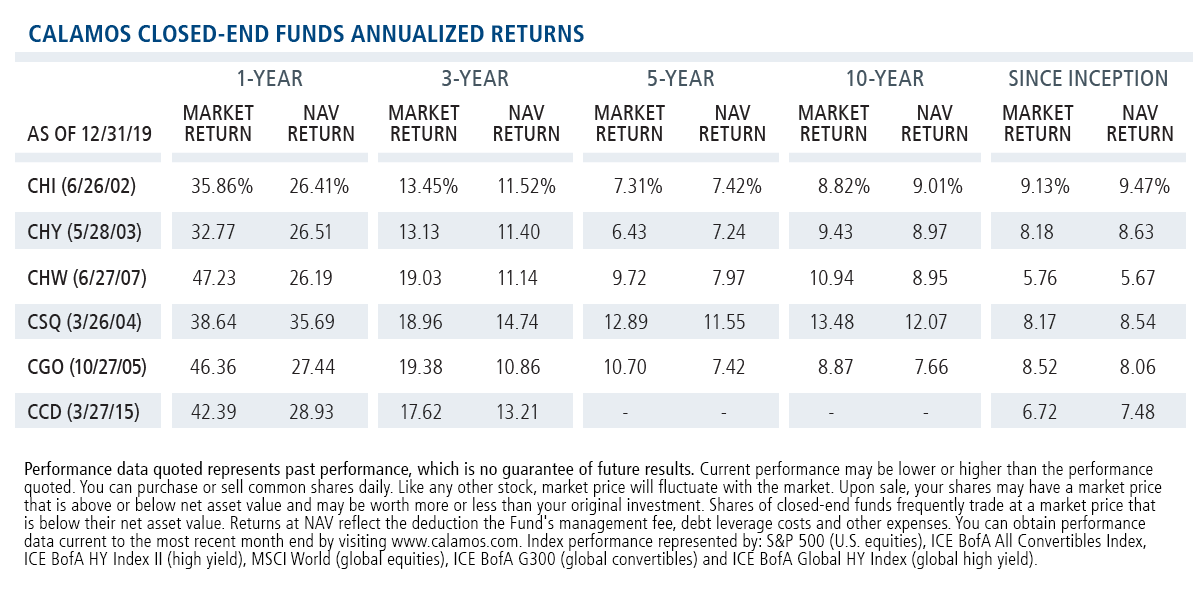
Opinions are subject to change due to changes in the market, economic conditions or changes in the legal and/or regulatory environment and may not necessarily come to pass. This information is provided for informational purposes only and should not be considered tax, legal, or investment advice. References to specific securities, asset classes and financial markets are for illustrative purposes only and are not intended to be, and should not be interpreted as, recommendations.
Important Risk Information. An investment in the Fund(s) is subject to risks, and you could lose money on your investment in the Fund(s). There can be no assurance that the Fund(s) will achieve its investment objective. Your investment in the Fund(s) is not a deposit in a bank and is not insured or guaranteed by the Federal Deposit Insurance Corporation (FDIC) or any other government agency. The risks associated with an investment in the Fund(s) can increase during times of significant market volatility. The Fund(s) also has specific principal risks, which are described below. More detailed information regarding these risks can be found in the Fund's prospectus.
Investments by the Fund(s) in lower-rated securities involve substantial risk of loss and present greater risks than investments in higher-rated securities, including less liquidity and increased price sensitivity to changing interest rates and to a deteriorating economic environment.
Fixed income securities are subject to interest rate risk; as interest rates go up, the value of debt securities in the Fund's portfolio generally will decline.
Each fund has specific risks, which are outlined in the respective funds' prospectuses. The general risks involved in investing in a closed end fund include market volatility risk, dividend and income risk, and loss of investment risk. Please refer to each fund's prospectus, annual and semi-annual reports at www.calamos.com for complete information on the fund's performance, investments and risks.
S&P 500 Index is generally considered representative of the U.S. stock market.
The ICE BofA All U.S. Convertibles Index (VXA0) comprises approximately 700 issues of only convertible bonds and preferreds of all qualities. Source ICE Data Indices, LLC, used with permission. ICE permits use of the ICE BofA indices and related data on an ‘as is’ basis, makes no warranties regarding same, does not guarantee the suitability, quality, accuracy, timeliness, and/or completeness of the ICE BofA Indices or data included in, related to, or derived therefrom, assumes no liability in connection with the use of the foregoing and does not sponsor, endorse or recommend Calamos Advisors LLC or any of its products or services.
The MSCI World Index is a free float-adjusted market capitalization weighted index that is designed to measure the equity market performance of developed markets.
ICE BofA Global 300 Convertible Index is a global convertible index composed of companies representative of the market structure of countries in North America, Europe and the Asia/Pacific region. Source ICE Data Indices, LLC, used with permission. ICE permits use of the ICE BofA indices and related data on an ‘as is’ basis, makes no warranties regarding same, does not guarantee the suitability, quality, accuracy, timeliness, and/or completeness of the ICE BofA Indices or data included in, related to, or derived therefrom, assumes no liability in connection with the use of the foregoing and does not sponsor, endorse or recommend Calamos Advisors LLC or any of its products or services.
ICE BofA Merrill Lynch Global HY Constrained Index tracks the performance of below-investment grade corporate debt denominated in US dollars, Canadian dollars, pounds and euros that are publicly issued in the major US or Eurobond markets.
ICE BofA US High Yield Index tracks the performance of US dollar denominated below investment grade corporate debt publicly issued in the US domestic market.
NOT FDIC INSURED | NO BANK GUARANTEE | MAY LOSE VALUE
801950A 0320
Archived material may contain dated performance, risk and other information. Current performance may be lower or higher than the performance quoted in the archived material. For the most recent month-end fund performance information visit www.calamos.com. Archived material may contain dated opinions and estimates based on our judgment and are subject to change without notice, as are statements of financial market trends, which are based on current market conditions at the time of publishing. We believed the information provided here was reliable, but do not warrant its accuracy or completeness. This material is not intended as an offer or solicitation for the purchase or sale of any financial instrument. The views and strategies described may not be suitable for all investors. This material has been prepared for informational purposes only, and is not intended to provide, and should not be relied on for, accounting, legal or tax advice. References to future returns are not promises or even estimates of actual returns a client portfolio may achieve. Any forecasts contained herein are for illustrative purposes only and are not to be relied upon as advice or interpreted as a recommendation.
Performance data quoted represents past performance, which is no guarantee of future results. Current performance may be lower or higher than the performance quoted. The principal value and return of an investment will fluctuate so that your shares, when redeemed, may be worth more or less than their original cost. Performance reflected at NAV does not include the Fund’s maximum front-end sales load. Had it been included, the Fund’s return would have been lower.
Archived material may contain dated performance, risk and other information. Current performance may be lower or higher than the performance quoted in the archived material. For the most recent month-end fund performance information visit www.calamos.com. Archived material may contain dated opinions and estimates based on our judgment and are subject to change without notice, as are statements of financial market trends, which are based on current market conditions at the time of publishing. We believed the information provided here was reliable, but do not warrant its accuracy or completeness. This material is not intended as an offer or solicitation for the purchase or sale of any financial instrument. The views and strategies described may not be suitable for all investors. This material has been prepared for informational purposes only, and is not intended to provide, and should not be relied on for, accounting, legal or tax advice. References to future returns are not promises or even estimates of actual returns a client portfolio may achieve. Any forecasts contained herein are for illustrative purposes only and are not to be relied upon as advice or interpreted as a recommendation.
Performance data quoted represents past performance, which is no guarantee of future results. Current performance may be lower or higher than the performance quoted. The principal value and return of an investment will fluctuate so that your shares, when redeemed, may be worth more or less than their original cost. Performance reflected at NAV does not include the Fund’s maximum front-end sales load. Had it been included, the Fund’s return would have been lower.
Archived on March 24, 2021Cookies
This website uses cookies. By continuing to use this website, you consent to the use of cookies. Learn more about our cookie usage.


